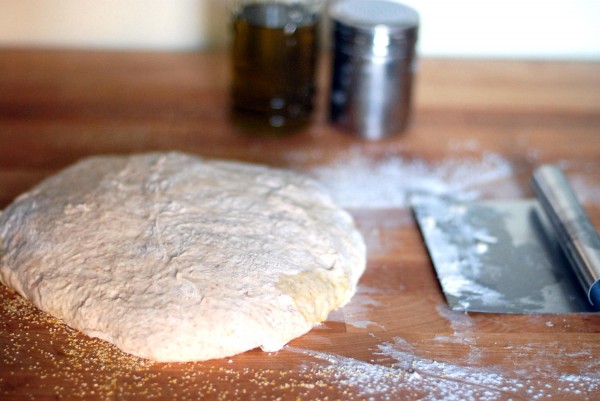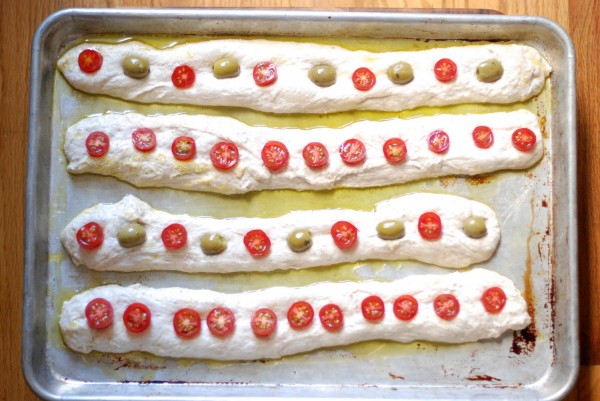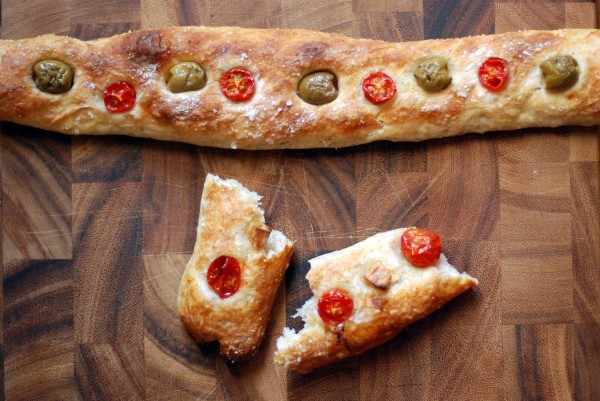In recent years, seemingly in complete indifference to logic and better judgment, I’ve settled on and stayed loyal to a bread recipe that’s a royal pain in the hinder parts. That recipe is Tartine’s Country Loaf, which I make plain, but also with olives, or cherries, or semolina and sesame and raisins (a favorite to get us through the colder months). It takes forever and is extremely involved. Did you want to do something fun on Sunday? I’m sorry, I can’t; I have to make bread.
But then summer rolls around, and summer in DC, as you know, is terrible, and my will to sit through hours of proofing and kneading and rising and 500-degree baking wilts as quickly as my poor plants in the August humidity. Fortunately, there are sane people like Jim Lahey in the world, who understand that sometimes, you don’t want to knead the bread, or sit at home and watch the bread, or really fuss with the bread at all. You just want to eat the bread. Is that so much to ask?
Turns out, it’s not. That’s why no-knead bread is wonderful (as are the many variations thereof). And in an effort to spruce up a recent Friday night dinner party with bread other than challah, I turned to yet another variation on Lahey’s original no-knead recipe: the Stecca.
Stecca is basically a long, wide breadstick. The recipe builds only minimally on the usual no-knead formula, and the result provided a nice change of pace from our usual routine.
And hopefully this goes without saying, but don’t feel bound to cherry tomatoes and olives; whole peeled garlic cloves, caramelized onions, or just some rosemary would also work well.
I’m starting to think you can do pretty much anything with this dough. Which is my way of saying, stay tuned for more no-knead riffs in the future.
What are you making this weekend?
No-Knead Breadsticks
Adapted from My Bread, by Jim LaheyI used halved cherry tomatoes and pitted olives in most of my steccas, but I popped a couple of garlic cloves into some of the sticks, and those were really delicious. Highly recommend doing that.
3 cups bread flour, plus more for the work surface
1/2 teaspoon salt
3/4 teaspoon sugar
1/4 teaspoon instant or other active dry yeast
1 1/2 cups cool (55 to 65°F) water
1/4 cup extra-virgin olive oil
3/4 teaspoon coarse sea salt, for sprinkling
1 pint cherry tomatoes, 1 cup pitted olives, 10 cloves of garlic, or any other topping you’d likeCombine flour, salt, sugar, and yeast in a medium bowl. Add the water and mix until you have a wet, sticky dough, about 30 seconds. Cover the bowl and let sit at room temperature until the surface is dotted with bubbles and the dough is more than doubled in size, at least 12 hours and up to 18 hours.
Generously dust a work surface with flour. Use a bowl scraper or rubber spatula to scrape the dough out of the bowl in one piece. Fold the dough over itself two or three times and gently shape it into a somewhat flattened ball. Brush the surface of the dough with some of the olive oil and sprinkle with 1/4 teaspoon of the coarse salt (which will gradually dissolve on the surface).
Place a tea towel on your work surface and generously dust it with wheat bran, cornmeal, or flour. Gently place the dough on the towel, seam side down. If the dough is tacky, dust the top lightly with wheat bran, cornmeal, or flour. Fold the ends of the tea towel loosely over the dough to cover it and place in a warm, draft-free spot to rise for 1 to 2 hours. The dough is ready when it is almost doubled. If you gently poke it with your finger, it should hold the impression. If it springs back, let it rise for another 15 minutes.
Half an hour before the end of the second rise, preheat the oven to 500°F  and set a rack in the center of the oven. Oil a 13-by-18-inch rimmed baking sheet. (If not rimmed, not the end of the world, but know that your oil may dribble off the sides of the pan.)
Cut the dough into quarters. Gently stretch each piece evenly into a stick shape approximately the length of the pan. Place on the pan, leaving at least 1 inch between the loaves. Brush with olive oil and sprinkle with the remaining 1/2 teaspoon coarse salt and any toppings you’re using.
Bake the baguettes for 15 to 25 minutes, until the crust is golden brown. Cool on the pan for 5 minutes, then use a strong spatula to transfer the stecca to a rack to cool thoroughly. Serve at room temperature, or reheat briefly in a warm oven.




Comments on this entry are closed.
What a great idea! Love this and am going to make for Shabbat.
Julie
These look so easy – can’t wait to serve them for Shabbat dinner Friday night!
Looks awesome!!
Hi!
Your blog has caught our attention because of the quality of the recipes. We would be delighted if you would join us at http://www.mytaste.com/ so that we could link to it.
myTaste.com is a search engine that compiles the best American cooking sites and blogs from the Internet. Several hundred blogs are already enrolled here and are taking benefit from the traffic we are sending to their sites.
To join myTaste, just go to http://www.mytaste.com/add-your-food-blog
Best regards,
Elin
MyTaste.com